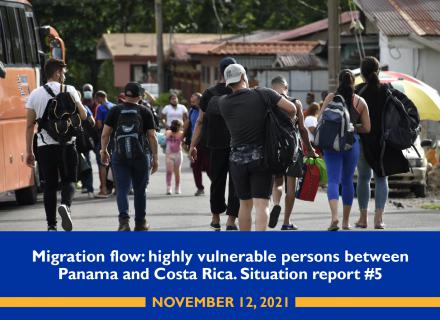The number of international migrants living abroad for work, education, displacement due to violence or climate change is steadily increasing. When disasters occur, migrants may face specific challenges in accessing vital information and assistance.
In line with IOM's Regional Strategy 2020-2024 for Central America, North America and the Caribbean, the Western Hemisphere Program seeks to strengthen the capacity of governments to manage all forms and impacts of mobility in emergencies and crises, and to build the resilience of communities and populations on the move, especially those in situations of vulnerability.
Leveraging tools such as the Guidelines for the Protection of Migrants in Countries Affected by Conflict or Natural Disasters (MICIC) and the Migration Crisis Operational Framework (MCOF), IOM promotes actions and public policies that support the integration of migrants’ needs and perspectives in emergency prevention, preparedness and response systems, in accordance with IOM’s principle to ensure that migration benefits all people.
It is important to note the link between climate change and emergencies. Climate change intensifies the magnitude and frequency of related hazards of hydrological origin, like floods; meteorological, like storms; climatological, like droughts and even biological, like the increase of infections such as zika and dengue. As these natural hazards may cause human mobility in critical situations, IOM addresses both topics considering this link.

Evacuations and Disaster Risk Reduction in the Caribbean
The Caribbean is vulnerable to a range of hazards and is experiencing increased frequency and intensity of climate change-induced hazards, forcing many – especially those residing in informal settlements and coastal zones – to evacuate as a mobility strategy to mitigate risk of harm and loss of life. Evacuations are a commonly used strategy to mitigate risk in the Caribbean, occurring in response to floods, hurricanes and other storms, landslides, volcanic eruptions, and other hazards. Evacuations in the region often happen internally, but cross-border evacuations are becoming increasingly common, drawing on the regional frameworks to permit free movement of people to save lives. This report delineates the key themes in evacuation practices in different Caribbean States, providing a regional view of policies and implementation efforts.

Costa Rica - Panama: Flow monitoring of people in mobility situations through the Americas #1 (December, 2021)
Since August 24, 2021, IOM Panama has published information on the irregular migration flow in Darien, Panama4 under the context of COVID-19. Based on this information, it has been identified that during 2021 the flow of people in a situation of mobility through the Americas with destination to North America is on the rise.

Finding Safer Ground: Planned Relocation Policies and Processes in The Caribbean
This research aims to expand the conversation about planned relocation and to focus specifically on Caribbean experiences. This report draws on good practices in order to provide tools for decision-making and to support States in addressing the needs of persons and communities that are vulnerable to the impacts of climate change. This study highlights opportunities to create more holistic and effective migration and disaster risk reduction policies and draws from interviews not only with government officials but also with community members who experienced the relocation, a critical perspective for understanding how relocations are planned and implemented.

Baseline for Haitian Migration Campaign
The objective of this communication strategy is to raise awareness among Haitian population with the intention of migrating and among people in transit countries (mainly Chile and Brazil) about the risks of irregular migration, especially in the Darién Gap in Panama, located on the border with Colombia.

If Not for Pure Necessity. Deaths and disappearances on migration journeys in North and Central America.
The report discusses the risks on routes across Central and North America, including the United States of America-Mexico border crossings, routes through Mexico, the Darien Gap and migration from and within the Caribbean.

Paso Canoas border. Migration flow: highly vulnerable persons between Panama and Costa Rica. Situation report #6. November 26, 2021.
It is known that from November 16 to 25, 2,355 migrants were registered leaving the MRS of Los Planes bound for Costa Rica. Key informants indicate that the current migration flow identified in Paso Canoas and surrounding host communities has been represented by people from Haiti, Cuba, Bangladesh and India.

Practical Guide for Communicating in the Context of Migratory Crises
This is a quick reference guide for IOM staff who are in the field attending a crisis and must communicate with the migrant population in countries of transit or destination. It is based on the operational frameworks of the IOM (MICIC, MCOF, among others), as well as on the principles of strategic communication and communication for development.

Paso Canoas border. Migration flow: highly vulnerable persons between Panama and Costa Rica. Situation report #5. November 12, 2021.
The migration flow of extraregional mirants transiting through Central America en route to North America, continues to increase. In Panama, according to data from the National Migration Service (SNM), between January and October 2021, 121.737 migrants of variosus nationalities, such as Haiti (62%), Cuba (13%), Chile (8%), Brazil (7%), the Bolivarian Republic of Venezuela (2%) and other countries in South America, Asia and Africa, have entered Panama irregularly at the border with Colombia. People identified as nationals of Chile and Brazil are children of Haitian migrants born in those countries.

Communication campaign on the risks of irregular migration through the Darien forest
The "Speak the Truth" (Pale Verite) campaign follows the "Migrants as Messengers" model and has adapted the C4D methodology to crisis and emergency contexts. It targets potential migrants in Haiti and Haitian migrants in South American transit countries. Its objective is to inform about the risks of irregular migration through the Darien jungle using the testimonies of those who have already lived the experience.




